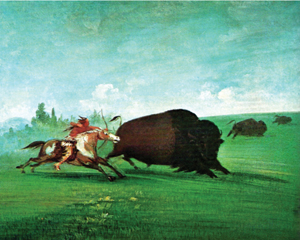
In the chase to overtake the powerful bull buffalo, portrayed in this painting by George Catlin, Native Americans sometimes had to gallop their horses five miles across the plains.
Images from The Story of America.
A LITTLE PIECE OF HISTORY | By Joan Frances –
Imagine life 200 years ago. You are standing on a mountain, discerning the vast acres of land before you. The breeze caresses your face, and the sun warms the earth. The spaciousness is a sight to see – so peaceful and quiet, just the wind and free breath. A large herd of buffalo can be seen for miles, grazing innocently, such a regal, large and powerful animal. Suddenly, gunshots break the tranquility. The buffalo begin to run, and several fall. For the Native Americans and many early settlers, this was not an act of sport or for pleasure. The buffalo was a vital source of food, clothing and shelter for years.
An estimated 60 million buffalo were present during the 1700s, flourishing from Canada to Mexico. There was never a shortage of food for the Native Americans. This animal, weighing up to 2,000 pounds, was not only their main diet, but virtually every portion was used for maintaining their lifestyle. Hides were used for clothing, footwear, bedding and shelter, as well as floors and sleeping mats. Sinew, a piece of tough fibrous tissue, was used for sewing and binding, and the bones were used as tools. The meat was eaten raw, some was cooked and other portions were dried as jerky. The choice cut was the hump roast, shared as a delicacy for special celebrations. Buffalo trails were used for travel by the Native Americans, explorers and pioneers because they were well packed and easy to follow. The buffalo, or “tatonka,” was the heart of Native American culture, and their future and was placed directly below the Great Spirit himself.

A buffalo shoot as illustrated in John C. Frémont’s memoirs.
When the Native Americans resisted the white settlers pouring into the west, the railroads and the army encouraged a mass slaughter of the buffalo in an effort to eradicate and drive out the Native Americans. Trains crossing the plains charged passengers $10 to shoot the buffalo from the windows of the moving trains. Professional buffalo hunters shot and killed hundreds of these animals a day, keeping the tongues and hides and leaving the rest to the vultures and to rot on the prairie. Bleached bones littered the land and were later gathered and proved profitable for the railroads. Workers were paid to haul tons of the skeletal remains east, and then the bones were crushed for carbon and fertilizer. These hunters did more in five years to force the Native Americans out of the area than the army could have done in 50 years. By 1885, fewer than 1,000 buffalo remained.
Buffalo in Fort Bend County lived and thrived along the Brazos River. Historical finds trace buffalo trails along the Brazos, and remains have been discovered near Richmond. Many of the roads used every day in Fort Bend County were once buffalo trails. When the Karankawa Native Americans inhabited the land along the river, notable warriors used bows, spears and firearms for procuring food. They lived on buffalo, fish and oysters.
Buffalo were hunted in different ways. Before horseback, the tribe members encircled the herd and fired a large volley of arrows until they killed an adequate number of these massive animals. When horses were acquired, it became easier, stampeding herds over a cliff or driving animals into a natural trap.
Thanks to the efforts of early pioneer ranchers, the population of the buffalo is replenished. Today, there are about 150,000 in North America. Spectators are still in awe over their immense size and calm nature. Tatonka will forever be a part of the history as one of the animals that shaped America’s future.